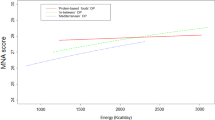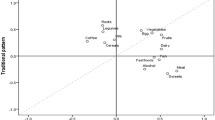Abstract
Background/Objectives:
Few studies have investigated dietary patterns among French adults. We aimed to identify dietary patterns and their relation with nutrient intakes, sociodemographic, lifestyle and other health indicators in a large population of middle-aged subjects living in France.
Subjects/Methods:
Dietary patterns were identified using factor analysis in 5194 women and men aged 45–60 years enrolled in the SU.VI.MAX (Supplémentation en Vitamines et Minéraux Antioxydants) study. Dietary data were based on repeated 24-h dietary records (at least six records during 2 years).
Results:
Four patterns were identified: (1) ‘alcohol and meat products’; (2) ‘prudent diet’; (3) ‘convenience foods’; and (4) ‘starch, sauces, and vegetables’. The first pattern was positively associated with low education, smoking and overweight in both genders, as well as with abdominal obesity in women and treated hyperlipidaemia and/or hypertension in men. The second pattern was positively correlated with high education and being older than 55 years and negatively correlated with current smoking. This pattern was also associated with overweight and low waist circumference in women and with hyperlipidaemia treatment in men. The third pattern was inversely related to age and positively related to higher education in both genders. In men, higher scores were related to living alone and an urban residence. The fourth pattern was associated with high education and an urban residence in men only.
Conclusions:
Our study identified four dietary patterns in this population of French middle-aged adults. Associations with sociodemographic, behavioural and health-related factors were found to differ according to dietary patterns. Sex-specific relationships were also found.
This is a preview of subscription content, access via your institution
Access options
Subscribe to this journal
Receive 12 print issues and online access
$259.00 per year
only $21.58 per issue
Buy this article
- Purchase on Springer Link
- Instant access to full article PDF
Prices may be subject to local taxes which are calculated during checkout
Similar content being viewed by others
References
Bamia C, Orfanos P, Ferrari P, Overvad K, Hundborg HH, Tjonneland A et al. (2005). Dietary patterns among older Europeans: the EPIC-Elderly study. Br J Nutr 94, 100–113.
Cade J, Thompson R, Burley V, Warm D (2002). Development, validation and utilisation of food-frequency questionnaires—a review. Public Health Nutr 5, 567–587.
Costacou T, Bamia C, Ferrari P, Riboli E, Trichopoulos D, Trichopoulou A (2003). Tracing the Mediterranean diet through principal components and cluster analyses in the Greek population. Eur J Clin Nutr 57, 1378–1385.
EASO (European Association for the Study of Obesity) (2002). Obesity in Europe: The Case for Action. International Obesity Task Force: London, UK.
Engeset D, Alsaker E, Ciampi A, Lund E (2005). Dietary patterns and lifestyle factors in the Norwegian EPIC cohort: the Norwegian women and cancer (NOWAC) study. Eur J Clin Nutr 59, 675–684.
Ferrieres J (2004). The French paradox: lessons for other countries. Heart 90, 107–111.
Greenwood DC, Cade JE, Draper A, Barrett JH, Calvert C, Greenhalgh A (2000). Seven unique food consumption patterns identified among women in the UK Women's Cohort Study. Eur J Clin Nutr 54, 314–320.
Hercberg S (coordinator) (2005). Table de Composition SU.VI.MAX des Aliments. Les éditions INSERM/Economica: Paris, 182pp.
Hercberg S, Preziosi P, Briancon S, Galan P, Triol I, Malvy D et al. (1998). A primary prevention trial using nutritional doses of antioxidant vitamins and minerals in cardiovascular diseases and cancers in a general population: the SU.VI.MAX study—design, methods, and participant characteristics. SUpplementation en VItamines et Mineraux AntioXydants. Control Clin Trials 19, 336–351.
Hoffmann K, Schulze MB, Schienkiewitz A, Nothlings U, Boeing H (2004). Application of a new statistical method to derive dietary patterns in nutritional epidemiology. Am J Epidemiol 159, 935–944.
Hu FB (2002). Dietary pattern analysis: a new direction in nutritional epidemiology. Curr Opin Lipidol 13, 3–9.
Jacques PF, Tucker KL (2001). Are dietary patterns useful for understanding the role of diet in chronic disease? Am J Clin Nutr 73, 1–2.
Kant AK (1996). Indexes of overall diet quality: a review. J Am Diet Assoc 96, 785–791.
Kant AK (2004). Dietary patterns and health outcomes. J Am Diet Assoc 104, 615–635.
Le Jeannic T, Vidalenc J (1997). Pôles urbains et périurbanisation—le zonage en aires urbaines. INSEE Première 516, 1–2.
Le Moullec N, Deheeger M, Preziosi P, Montero P, Valeix P, Rolland-Cachera MF et al. (1996). Validation du manuel photos utilisé pour l’enquête alimentaire de l’étude SU.VI.MAX. Cahier de Nutrition et de Diététique 31, 158–164.
Martinez ME, Marshall JR, Sechrest L (1998). Invited commentary: factor analysis and the search for objectivity. Am J Epidemiol 148, 17–19.
McCullough ML, Feskanich D, Rimm EB, Giovannucci EL, Ascherio A, Variyam JN et al. (2000). Adherence to the dietary guidelines for Americans and risk of major chronic disease in men. Am J Clin Nutr 72, 1223–1231.
Moeller SM, Reedy J, Millen AE, Dixon LB, Newby PK, Tucker KL et al. (2007). Dietary patterns: challenges and opportunities in dietary patterns research an Experimental Biology workshop, April 1, 2006. J Am Diet Assoc 107, 1233–1239.
Naska A, Fouskakis D, Oikonomou E, Almeida MD, Berg MA, Gedrich K et al. (2006). Dietary patterns and their socio-demographic determinants in 10 European countries: data from the DAFNE databank. Eur J Clin Nutr 60, 181–190.
Nettleton JA, Steffen LM, Schulze MB, Jenny NS, Barr RG, Bertoni AG et al. (2007). Associations between markers of subclinical atherosclerosis and dietary patterns derived by principal components analysis and reduced rank regression in the Multi-Ethnic Study of Atherosclerosis (MESA). Am J Clin Nutr 85, 1615–1625.
Newby PK, Tucker KL (2004). Empirically derived eating patterns using factor or cluster analysis: a review. Nutr Rev 62, 177–203.
Newby PK, Muller D, Hallfrisch J, Andres R, Tucker KL (2004). Food patterns measured by factor analysis and anthropometric changes in adults. Am J Clin Nutr 80, 504–513.
Newby PK, Muller D, Hallfrisch J, Qiao N, Andres R, Tucker KL (2003). Dietary patterns and changes in body mass index and waist circumference in adults. Am J Clin Nutr 77, 1417–1425.
Newby PK, Weismayer C, Akesson A, Tucker KL, Wolk A (2006). Longitudinal changes in food patterns predict changes in weight and body mass index and the effects are greatest in obese women. J Nutr 136, 2580–2587.
Pala V, Sieri S, Masala G, Palli D, Panico S, Vineis P et al. (2006). Associations between dietary pattern and lifestyle, anthropometry and other health indicators in the elderly participants of the EPIC-Italy cohort. Nutr Metab Cardiovasc Dis 16, 186–201.
Paradis AM, Perusse L, Vohl MC (2006). Dietary patterns and associated lifestyles in individuals with and without familial history of obesity: a cross-sectional study. Int J Behav Nutr Phys Act 3, 38.
Park SY, Murphy SP, Wilkens LR, Yamamoto JF, Sharma S, Hankin JH et al. (2005). Dietary patterns using the Food Guide Pyramid groups are associated with sociodemographic and lifestyle factors: the multiethnic cohort study. J Nutr 135, 843–849.
Perrin AE, Dallongeville J, Ducimetiere P, Ruidavets JB, Schlienger JL, Arveiler D et al. (2005). Interactions between traditional regional determinants and socio-economic status on dietary patterns in a sample of French men. Br J Nutr 93, 109–114.
Pryer JA, Nichols R, Elliott P, Thakrar B, Brunner E, Marmot M (2001). Dietary patterns among a national random sample of British adults. J Epidemiol Community Health 55, 29–37.
Sanchez-Villegas A, Delgado-Rodriguez M, Martinez-Gonzalez MA, Irala-Estevez J (2003). Gender, age, socio-demographic and lifestyle factors associated with major dietary patterns in the Spanish project SUN (Seguimiento Universidad de Navarra). Eur J Clin Nutr 57, 285–292.
Schulz M, Nothlings U, Hoffmann K, Bergmann MM, Boeing H (2005). Identification of a food pattern characterized by high-fiber and low-fat food choices associated with low prospective weight change in the EPIC-Potsdam cohort. J Nutr 135, 1183–1189.
Schulze MB, Hoffmann K (2006). Methodological approaches to study dietary patterns in relation to risk of coronary heart disease and stroke. Br J Nutr 95, 860–869.
Schulze MB, Fung TT, Manson JE, Willett WC, Hu FB (2006). Dietary patterns and changes in body weight in women. Obesity (Silver Spring) 14, 1444–1453.
Schulze MB, Hoffmann K, Kroke A, Boeing H (2001). Dietary patterns and their association with food and nutrient intake in the European Prospective Investigation into Cancer and Nutrition (EPIC)-Potsdam study. Br J Nutr 85, 363–373.
Togo P, Osler M, Sorensen TI, Heitmann BL (2001). Food intake patterns and body mass index in observational studies. Int J Obes Relat Metab Disord 25, 1741–1751.
Togo P, Osler M, Sorensen TI, Heitmann BL (2004). A longitudinal study of food intake patterns and obesity in adult Danish men and women. Int J Obes Relat Metab Disord 28, 583–593.
Trichopoulou A, Kouris-Blazos A, Wahlqvist ML, Gnardellis C, Lagiou P, Polychronopoulos E et al. (1995). Diet and overall survival in elderly people. BMJ 311, 1457–1460.
Tseng M, DeVellis RF (2001). Fundamental dietary patterns and their correlates among US whites. J Am Diet Assoc 101, 929–932.
Villegas R, Salim A, Collins MM, Flynn A, Perry IJ (2004). Dietary patterns in middle-aged Irish men and women defined by cluster analysis. Public Health Nutr 7, 1017–1024.
Whichelow MJ, Prevost AT (1996). Dietary patterns and their associations with demographic, lifestyle and health variables in a random sample of British adults. Br J Nutr 76, 17–30.
Willett W, Stampfer MJ (1986). Total energy intake: implications for epidemiologic analyses. Am J Epidemiol 124, 17–27.
Willett WC (1998). Nutritional Epidemiology. Oxford University Press: New York, NY.
Yang EJ, Kerver JM, Song WO (2005). Dietary patterns of Korean Americans described by factor analysis. J Am Coll Nutr 24, 115–121.
Acknowledgements
We thank all the scientists who helped to carry out the SU.VI.MAX study, the teams that assisted in the fieldwork, and the dedicated and conscientious volunteers who participated in this cohort. We also thank Stacie Chat-Yung for reviewing and editing the manuscript.
Author information
Authors and Affiliations
Corresponding author
Additional information
Contributors: EK-G carried out the data checking and analyses and was responsible for writing the manuscript. FB, SB, SP, CE, LD, A-CV, SC, PG and SH were involved in data checking and in assisting with the preparation of the manuscript. PG and SH were responsible for design and protocol development of the study.
Supplementary Information accompanies the paper on European Journal of Clinical Nutrition website (http://www.nature.com/ejcn)
Supplementary information
Rights and permissions
About this article
Cite this article
Kesse-Guyot, E., Bertrais, S., Péneau, S. et al. Dietary patterns and their sociodemographic and behavioural correlates in French middle-aged adults from the SU.VI.MAX cohort. Eur J Clin Nutr 63, 521–528 (2009). https://doi.org/10.1038/sj.ejcn.1602978
Received:
Revised:
Accepted:
Published:
Issue Date:
DOI: https://doi.org/10.1038/sj.ejcn.1602978
Keywords
This article is cited by
-
The FLY-project: study protocol for mixed methods research to explore the complex social dynamics of sustainable food-related lifestyles in youth in practical education
BMC Nutrition (2023)
-
Caribbean nutrition transition: what can we learn from dietary patterns in the French West Indies?
European Journal of Nutrition (2021)
-
Socio-demographic and lifestyle determinants of dietary patterns in French-speaking Switzerland, 2009–2012
BMC Public Health (2018)
-
Identification of major dietary patterns in Korean adults and their association with cancer risk in the Cancer Screening Examination Cohort
European Journal of Clinical Nutrition (2017)
-
Socioeconomic predictors of dietary patterns among Guatemalan adults
International Journal of Public Health (2016)



